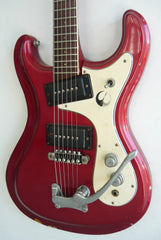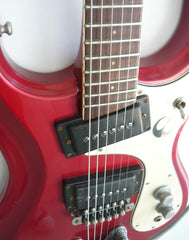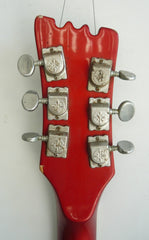Over the years I've collected A LOT of Mosrite copies and Mosrite inspired guitars. Back before I could afford or even find Mosrites, there were copies around that were cheaper and easier to come by. Without having played a real Mosrite at the time I didn't know how close, or in some cases, far away from the real thing some of them were. After eventually owning A LOT of Mosrites and having kept a lot of the cheaper copies I'd bought I realized that not many came close to the "real thing" at all. The unofficial official Mosrite Japan copies come closest and some of these are pretty good guitars in their own right. I'll blog more about them as time goes by.
Having always loved and collected cheap Japanese guitars like Teisco, Tokai and others I ended up with Mosrite copies by many strange and wonderful companies including these two along with Guyatone, Greco, Ibanez, Honey, Minister, Firstman, Coronet, Sakai, Morales, Arai (Aria/Univox), Audition, Kawai and a few with no names or missing headstock "badges" that I've never identified. When I say "Mosrite copy" I actually mean "Mosrite inspired" but to me a Mosrite copy has to have the offset body with the longer bottom horn, not just a weird shape with a German carve like some people insist. That longer bottom horn is one of the key elements in that great Mosrite design. I'll do some stories on some of these other copies as time permits if anyone's interested?
One of my favourite Mosrite copies was produced by Teisco in the very late 60's after the Kawai takeover of Teisco. It was branded Excetro, and like Firstman, Idol and Honey was built by Teisco-Gen-Gakki (some later by Matsumoku) and it basically traced straight off a Ventures model with very similar hardware and contours. It's not one of my favourites because it kind of feels and plays like a real one, but I think it's a great looking guitar heavily based on the Mosrite aesthetic, and it plays well. Really well.

It's a thick laminated body with a German carve, although not as intricate and flowing as the real Mosrite one, which at the time was hard to replicate with machines. The German carve on Mosrite was mostly finished by hand at this stage and Japanese mass production didn't take the time involved on cheaper models like this. This is certainly no "beginner" guitar and is solid and feels like a good quality intermediate to professional guitar. Not as good as a real Mosrite, but certainly better than most of the cheap knock offs being pumped out to supply demand of a market gone Ventures crazy.

The neck is thin and straight and feels much like a later 60's Mosrite neck. The thin, shallow feel and bound rosewood fretboard with zero fret are all very Mosrite. It has the volute and small (not as small) dot markers in the same configuration as Mosrite used.
The pickups are copies of the Mosrite single coil, but these have stamped metal covers instead of plastic but are essentially the same size and have the surrounds like the real ones. They are punchy and fat just like Mosrite pickups and have that sparkle that gave a million surf bands their sound.

The vibrato and bridge are based on the Mosrite unit with the vibrato being the "half trem" used by Mosrite mainly on their hollow bodies at the time. The bridge has roller saddles like the originals, but the bridge is more intricate in its design and execution which many of the Japanese units had. All the scratchplate and control set up is pure Mosrite.
These had the classic Teisco tuner which are getting hard to find intact these days and they're a quality item and, when looked after, are very functional and feel great.

All these Mosrite copies, like Fender, Gibson, Ric and Gretsch copies from Japan in the late 60's filled a gap in the guitar retail world that the US manufacturing just couldn't achieve at the time. The entry level student stuff can leave a lot to be desired and weren't really aimed squarely at quality guitar buyers, but these intermediate models were quality guitars, in your favourite shapes for less than half the price. I'm not sure, and I can't find much sales info on these Excetros from new, but they certainly would have been MUCH cheaper than a new Mosrite at the time and they also made a lot of Rickenbacker copies (and Fender and Gibson) that were of similar quality to this.








